Visiting the Grand Canyon in January is a magical time. January is a peaceful time to visit with not too many crowds.
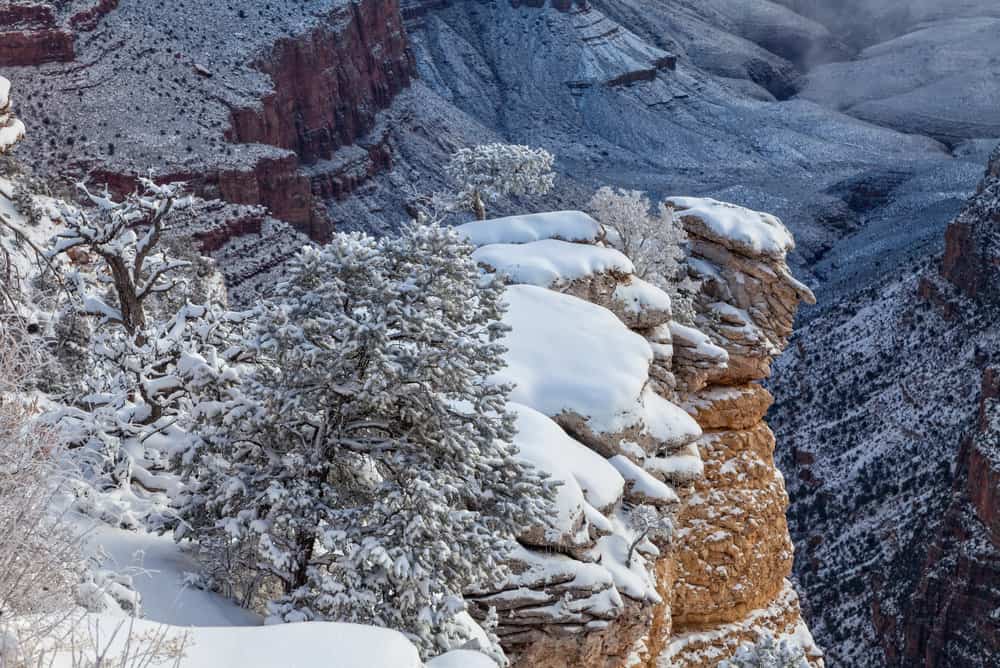
I’ve included all of the things to do in the Grand Canyon in November and tips and tricks for visiting. You can also use the Grand Canyon self guided tour to learn more about the Grand Canyon when you visit.
Weather in the Grand Canyon in January
In January, the daytime maximum temperature is 58 degrees Fahrenheit (14 degrees Celsius), while the overnight minimum is 34 degrees Fahrenheit (1 degree Celsius). The Grand Canyon covers a huge area and each section has a varied temperature.
Dress in layers and you will be fine!
Thank you for supporting this website written by an American. This post may contain affiliate links. This means I earn a small commission on these links at no extra cost to you.
National Park Entrance Fees
To enter the National Parks, you’ll need to pay an entrance fee or have a National Parks Pass also known as American the Beautiful Pass.
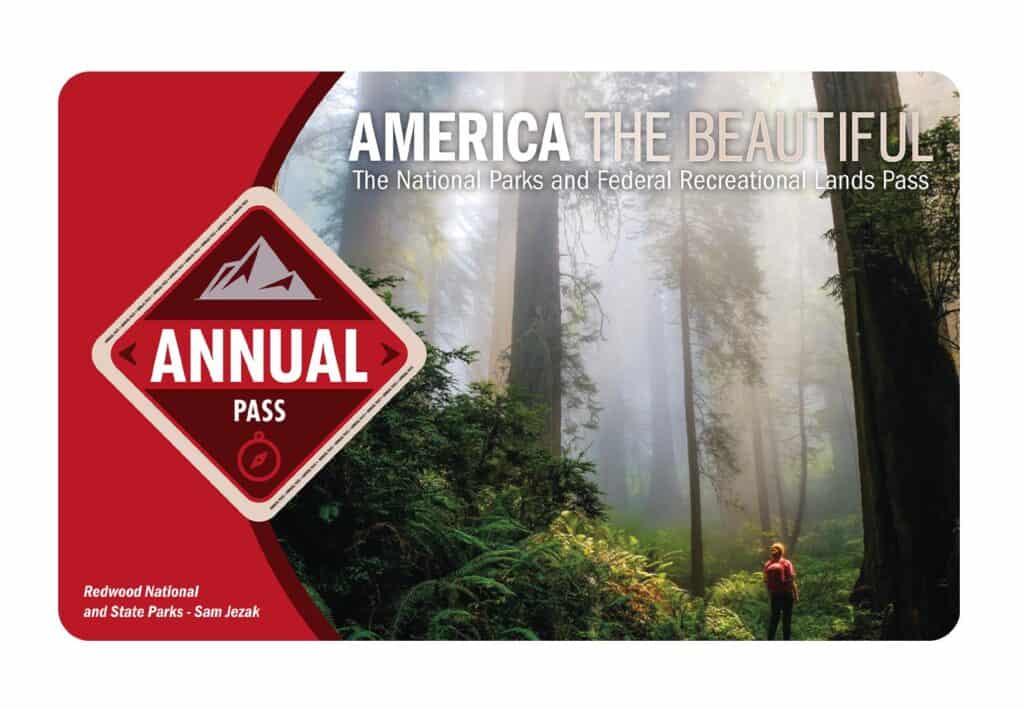
It costs $80 for a yearly America the Beautiful Pass. This gives you access to all national parks and federal areas that charge fees. The America the Beautiful Pass is well worth it!
I purchased my first one in 2016 and it’s such a money-saver! Plus 10% of sale proceeds go to the National Park Foundation.
Tips for Visiting Grand Teton National Park
Grand Canyon National Park is perfect for outdoor enthusiasts. There is something for everyone on this list and for different fitness levels. Also, note that it is dry and hot (in the summer), and make sure you know what you are getting into before you start. Here are a few tips for visiting the Grand Canyon:
- Bring a reusable water bottle and lots of water! Remember you are in the sun and you will need to drink lots of water. I love my LifeStraw Filtered Water Bottle. I can refill this bottle anywhere and it comes with a carabiner to connect it to my daypack.
- Check the Weather – days over 100 degrees are very common. Make sure to check.
- Hiking boots or sandals that will protect your feet! I love good shoes. I need all the support and help I can get. I actually love these sandals for hiking and also love these hiking boots.
- Bring hiking poles for balance and to protect your knees. I know many experienced hikers (and even amateur ones) think that hiking poles are for old people who lose their balance. Actually, hiking poles can help when going down steep inclines or when scrambling over rocks. They are great to hike with even for the most experienced hiker.
- Wear a sunhat. I feel like this whole post is about how high you are in the mountains and how much closer you are to the sun but it is so true. At elevation, you are closer to the sun and more likely to burn. Wear sun protection such as a sun hat and sunscreen.
- Be aware of the wildlife. This is the Southwest and you will need to watch out for snakes and other wildlife such as moose or a bear. Please stay away from wildlife and do not feed them. I recommend carrying bear spray as well.
- Start Early – If you want to avoid the traffic and the heat you will need to start your hike early. That way it will be nice and cool and the smog will not affect you either.
- Leave no trace. If you are new to the concept of Leave No Trace it is all about preserving the environment to ensure it is in the same or better condition when you leave it. This means that you should stick to the trails and carry out everything that you carried in. This is a great explanation of the Leave No Trace principles!
- Water shoes are great for water hikes– If you don’t have a pair, I highly suggest it as they are affordable. I have an article on the pros and cons of several pairs of water shoes.
- Bring Bug Spray and a snack: Be sure to bring everything you need including a snack like a protein bar plus BUG SPRAY.
Where to stay near Grand Canyon National Park
The Grand Canyon makes for a great weekend escape. Fresh air, beautiful scenery and being in nature does a world of good for the soul. I recommend staying as close to the park as possible and even treating yourself with a cabin with a spa pool to relax at night.
- There are lots of fantastic Airbnbs near the Grand Canyon. I have made a list of the best airbnbs around the park wherever you decide to stay. You can also check out my post on Where to Stay near the Grand Canyon to find the perfect hotel for any budget.
If you are taking a road trip remember to reserve a car in advance using Discover Cars .
15 Things to do in the Grand Canyon in January
Grand Canyon South Rim: Self-Guided Tour
See a natural wonder of the world in person on this self-guided driving tour of the Grand Canyon’s South Rim.

This self-guided driving tour takes you to all the best vistas, hikes, and attractions along Grand Canyon’s South Rim and tells you the secret history behind this famous landscape. Walk the scenic South Rim Trail, catch a sunset at Mather Point, and much more.
Visitor Center
As it is closest to all of the parking lots and Mather Point, begin at the main visitor center. Maps, park ranger interactions, canyon-related displays, and a 20-minute video titled “Grand Canyon: A Journey of Wonder” are all available here.

The visitor center, which is next to the south entry station at the south rim, is open Monday through Friday from 9 a.m. to 4 p.m. throughout the winter. You can learn about the current weather conditions, whether it’s safe to hike certain trails, whether some trails are closed, and which vistas are the safest to visit at the visitor center.
The main park store is also located across the plaza from the visitor center and is always worth a visit. In this main square, you can also find Bright Angel Bike Rentals. If it’s cold or snowing outside, you might not want to rent a bike or go on a bike tour, but you can stop by the shop’s café for a coffee or hot chocolate instead because they have the best coffee in the Grand Canyon!
Helicopter Ride down into the Grand Canyon
At the Grand Canyon, helicopter tours are accessible all year long. You should experience the vistas of the canyon covered with snow in December.
Even though there are many excursions available, the Grand Canyon Helicopter Tour is among the best. During the 45-minute flight, you will fly over the South Rim and the Kaibab National Forest.
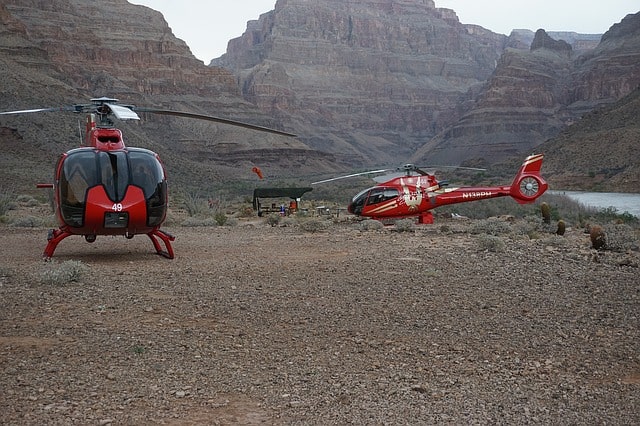
Experience the canyons by looking down into them on a helicopter tour or simply viewing them from a vantage point.
These helicopter rides, though perhaps a bit pricy, are well worth it and will provide you with priceless memories.
Experience the Spirit Helicopter Tour if you want to make this a trip you’ll never forget. The most popular and affordable helicopter tour leaving from the South Rim is this one.
The Spirit Tour, which flies over the Painted Desert, Kaibab National Forest, and—best of all—the Dragon Corridor, the widest and deepest section of the Grand Canyon, gives you some of the be
Mather Point
In addition to being close to the visitor center and parking lots, Mather Point is the most popular location to watch the sunset. This is a must-see in this wintertime sunset. At this time of year, you can easily catch the sunset before going out to dinner because the days are shorter.
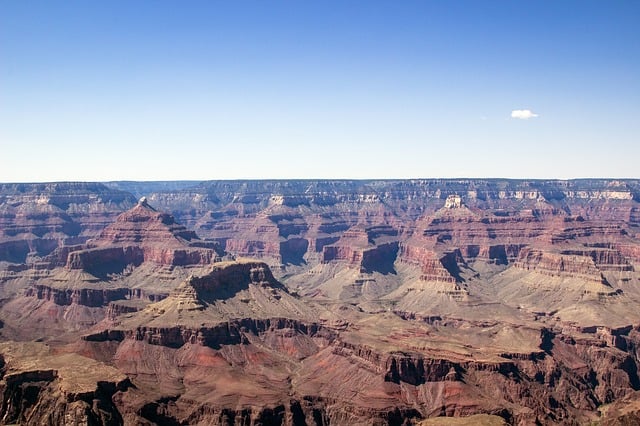
No matter what you do, stay for a few minutes after the sun has officially dipped beyond the horizon. At this time of year, the winter sky frequently takes on beautiful pink and purple tones.
Yaki Point
Although the East Rim Drive of the Grand Canyon isn’t the most well-traveled part of the canyon, Yaki Point has one of the most impressive views of the canyon, which encourages many people to visit it.
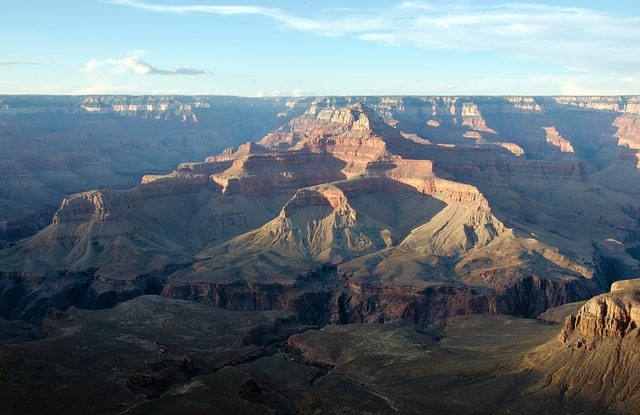
Yaki Point is located at the easternmost point of the Kaibab Trail Route and is a no-vehicle zone, so visitors must hike there from the neighboring parking lot or shuttle bus.
You can see a large portion of the South Kaibab Trail as it begins to extend towards O’Neill Butte and Cedar Ridge, as well as the end of the Bright Angel Trail. To the east are Cremation Creek and many magnificent buttes and mesas. Yaki Point undoubtedly has something special to offer to those who are intrigued.
Grandview Point
Grandview Point, located halfway between Desert View and Grand Canyon Village and accessible by a one-mile side road, is the southernmost point on the south rim of the Grand Canyon.

Because the official viewpoint is partially obscured by trees, the best views of the point can be found a short distance down the Grandview Trail. Due to Grandview’s high elevation (7,400 feet), which receives more rainfall, the woodland there is taller and thicker, with a mixture of oak, ponderosa pine, and pinyon pine trees.
Grandview was the first area along the rim to be developed for tourists before El Tovar Lodge was constructed next to Garden Canyon. This area had services, including a hotel built in 1895, but it was abandoned after only a few years of operation, leaving little evidence today.
Moran Point
One of the most popular stops along the east rim drive is Moran, which provides expansive views of a sizable portion of the Grand Canyon roughly between river miles 87 and 72.
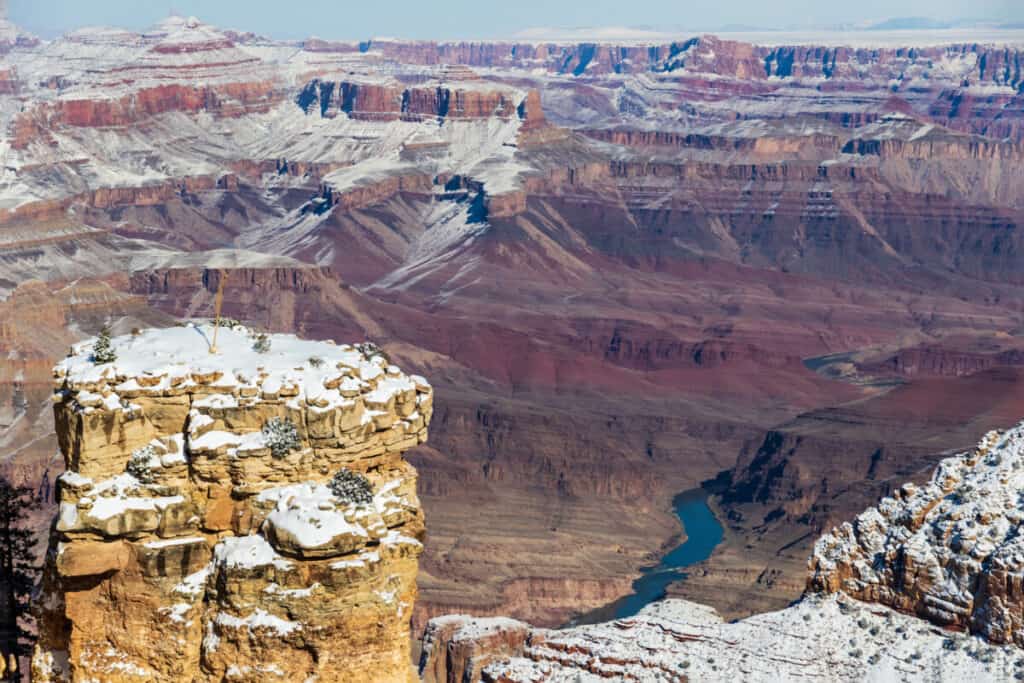
The point is just 8 miles away in a straight line, but 215 miles away by car, due south of Cape Royal on the North Rim. The canyon’s popularity increased after landscape painter Thomas Moran visited for the first time and helped popularize the promontory, which can be reached via a brief offshoot road. As a result, the canyon was later designated as a national monument.
Directly below Moran Point is Red Canyon, particularly where deep red/orange layered rocks made of Hakatai shale are displayed.
The flat, light-colored plateau between Red Canyon and the drainage to the north is made of Bright Angel shale from the Cambrian era, which is over 600 million years younger than the pre-Cambrian Hakatai.
This location is one of many unconformities in the strata of the canyon, where adjacent rocks are separated by long periods of geological time. The New Hance Trail travels along Red Canyon before coming to an intersection with the Escalante Route directly across from the narrowly discernible Hance Rapids.
Maricopa Point
The Grand Canyon’s edge is relatively narrow at Maricopa Point, reaching to the northeast for 100 feet before abruptly disappearing, while it continues much further below as a thin ridge between Horn Creek and the bigger Garden Creek. The first stop on the west rim shuttle bus tour is Trailview Overlook, although this is the second one.
There are no significant barriers between Maricopa and the river, and views of the Grand Canyon extend over 180 degrees from here. While most of the Bright Angel Trail is obscured by the Battleship formation, several miles of the Tonto Trail is visible as they wind past Horn Creek and Dana Butte and down Garden Creek.
Hopi Point
Hopi Point, which lies on Hermits Road, is one of the must-see locations along the canyon’s western rim. One of the best canyon views is arguably found around halfway down the 7-mile route.
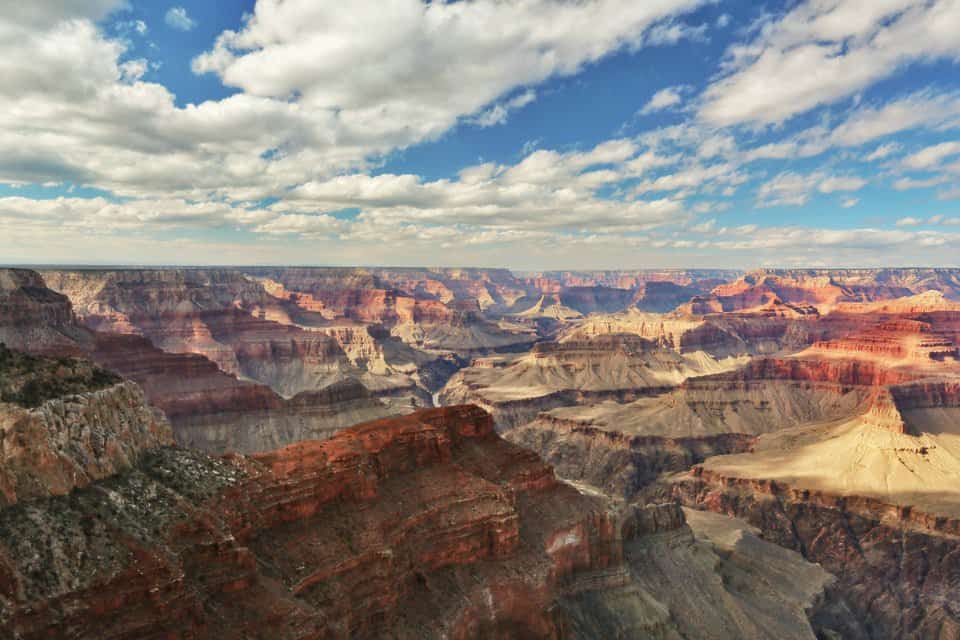
Due to the breathtaking panoramic views of the Colorado River, Dana Butte, and sweeping canyons, Hopi Point is one of the most well-known viewpoints along the west rim. Due to the expansive views, Hopi Point is regarded as one of the best locations to view the dawn and sunset.
To get to Hopi Point, the park does provide shuttle buses along Hermit Road if it is snowy and the roads are judged hazardous for private vehicles. ensuring that you have the opportunity to witness this stunning view regardless of the weather.
Winter is the only time of year when Hermit’s Road is accessible to private vehicles, so now is the perfect time to arrange your trip.
Mohave Point
The 3,000-foot-high, nearly vertical cliffs that surround The Abyss and stretch two miles to the west, towards Pima Point, may be seen well from Mohave Point. Three of the following sites, which are Yuma, Cocopa, and Havasupai, are further west, fading into the distance.
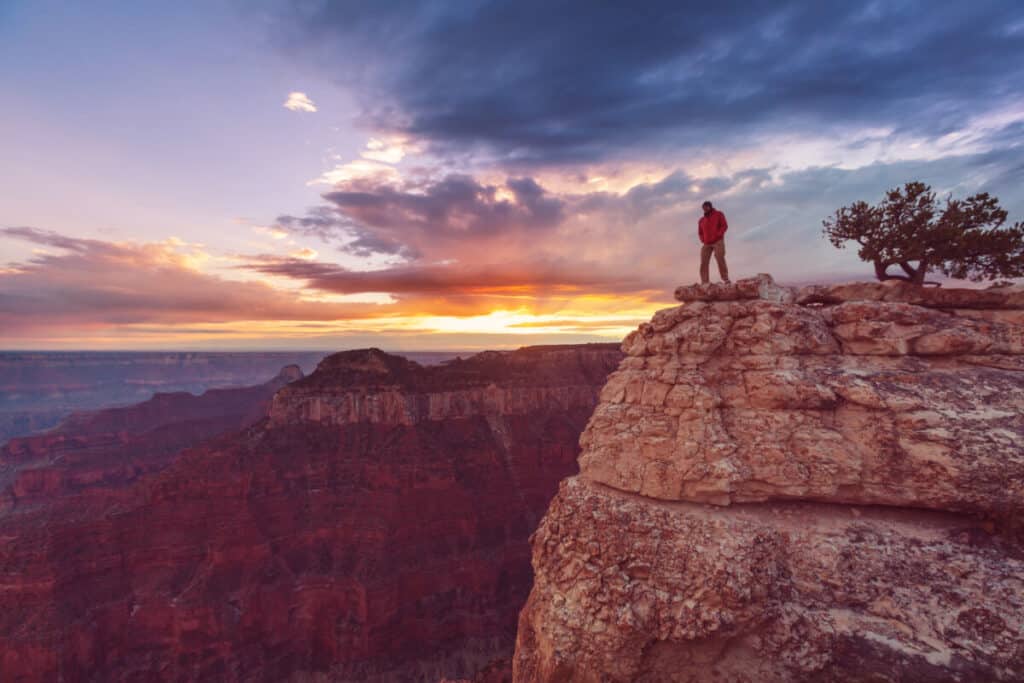
The view starts with Bright Angel Canyon on the North Rim and includes Ninety-one Mile Creek, Trinity Creek, and Ninety-four Mile Creek because the ridge stretching from Hopi Point blocks some of the canyons in the east.
Along with Hopi Point, Mohave is one of only two eastbound stops on the Hermit’s Rest shuttle bus route, and both are well-known spots to see the setting sun. Hopi offers more panoramic views, but Mohave offers multiple overlooks rather than just one, has a smaller visitation population, and is therefore generally more tranquil.
Additionally, The Alligator, a striking red sandstone mesa with sharp edges, is located directly underneath Mohave Point.
The Abyss
The Abyss doesn’t protrude out into the canyon like some of the other picturesque vantage sites along Hermit Road. This is a steep, notched, or hollow indentation in the canyon walls that plunges precipitously almost 3,000 feet into the Grand Canyon to the Redwall Formation.

This picturesque vantage point in Grand Canyon National Park provides views of Monument Creek, the Tonto Plateau, the Colorado River, Granite Rapids, and the Monument, a sizable sandstone column in the Grand Canyon, in addition to a slightly frightful, steep, vertical view down the canyon into the Monument Creek drainage area.
Your favorite part of the Canyon Rim Trail along Hermit Road might be the hike from Mohave Point to The Abyss. As you make your way up stone stairs and along a rock wall at the edge of the canyon, snowflakes will be gently drifting around you. On a long stretch of the walled overlook, you can unwind at a solitary picnic table and take in The Abyss.
Pima Point
Pima is the final point along West Rim Drive, but the road continues for another 1.5 miles to Hermit’s Rest, which contains a gift shop, restrooms, and a cafe. However, the views from here are somewhat limited because the canyon edge is quite densely forested and the overlook is at the end of a side canyon.
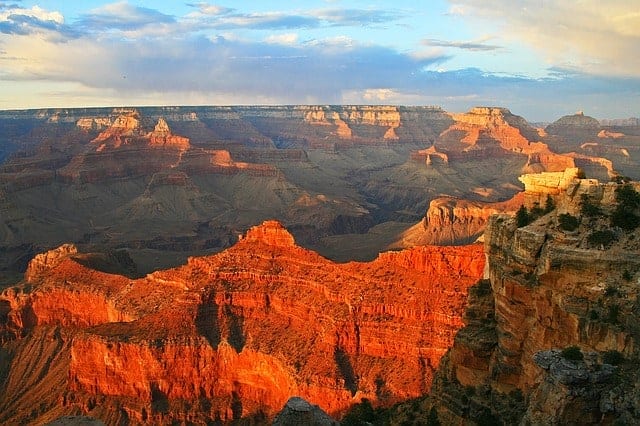
There is nothing to obstruct the view of the Grand Canyon from Pima Point, which is located at the northernmost corner of a broad promontory. The view extends over 40 miles, from Bright Angel Canyon in the east, all the way to the Powell Plateau, and the Great Scenic Divide in the west.
Hermit Creek’s deep, red canyon dominates the foreground on the west side, and the rocks that rise sharply up to the next two points may be seen there (Yuma and Cocopa). In contrast to the mostly dry cliffs and canyons further west, the lower portion of the creek features year-round flowing water and a short corridor of vivid green flora.
The Hermit Trail can be seen in many places, snaking through Travertine Canyon, crossing Hermit Creek, and zigzagging down Cope Butte. In the eastern panorama, a beautiful vista along Ninety-four Mile Creek may be seen just across from Monument Creek, the Granite Rapids, and The Alligator.
Grand Canyon Village
Grand Canyon Village draws a lot of visitors since it is the park’s most well-liked entrance point. However, there’s a reason for the area’s popularity: it’s home to Yavapai Point, one of the best vantage spots for viewing the canyon.
You might visit Grand Canyon Village for lunch after a morning of sightseeing. Additionally available are the Maswik Food Court, the Bright Angel Restaurant, and the traditional El Tovar Dining Room. The dining area is relatively affordable for its position, which is close to the Bright Angel Trail trailhead and offers views of the Grand Canyon.
These little cabins are perfect for snuggling up with hot cocoa after a winter stroll, especially with the likelihood of snow in the Grand Canyon. If you want to be in the park but don’t want to tent, this is where you should go. This area of the Grand Canyon is the busiest and has the most lookouts.
Hermit’s Rest Scenic Drive
Hermit Road, a well-known 7-mile circuit that begins at Hermits Rest and travels along several picturesque overlooks, is situated near the westernmost point of the south rim.

Along this route, shuttle buses run by the Grand Canyon are available and the highway is accessible to private vehicles in January.
Some of the canyon’s best vistas, including those from Hopi Point, Mohave Point, and Pima Point, can be found along this route.
Plateau Point
Although the Plateau Point Trail, which is 1.5 miles long, is not particularly challenging, the entire adventure—from the South Rim Trail to the beautiful viewpoint—is 12 miles round trip.
Just past the ranger station and mule corrals at the northern end of Indian Garden, the Plateau Point Trail begins. After crossing Garden Creek and leaving the shade behind, proceed west along the Plateau Point Trail. Follow the Tapeats sandstone’s contours as it crosses a dry plateau and a series of ravines. There is no shade here; instead, cacti and other vegetation cover the generally level desert terrain.
Turn right to head northeast at the intersection of the West Tonto Trail and the fork. From here, you can almost directly ascend across the Tonto Platform to the viewpoint. To get to a flat top rock and a viewing platform, pass a water tank and a mule hitching post. See if you can spot Rafters navigating Horn Rapids while admiring the breathtaking scenery.
Kids should not play near the edge! This trail allows mules to watch out for their droppings.
Desert View Watchtower
On the park’s South Rim, Desert View is the area with the biggest concentration of development. The Watchtower, a designated National Historic Landmark, was built in 1932. This specific tower was modeled after the Hovenweep Round Tower and the Mesa Verde Round Tower.
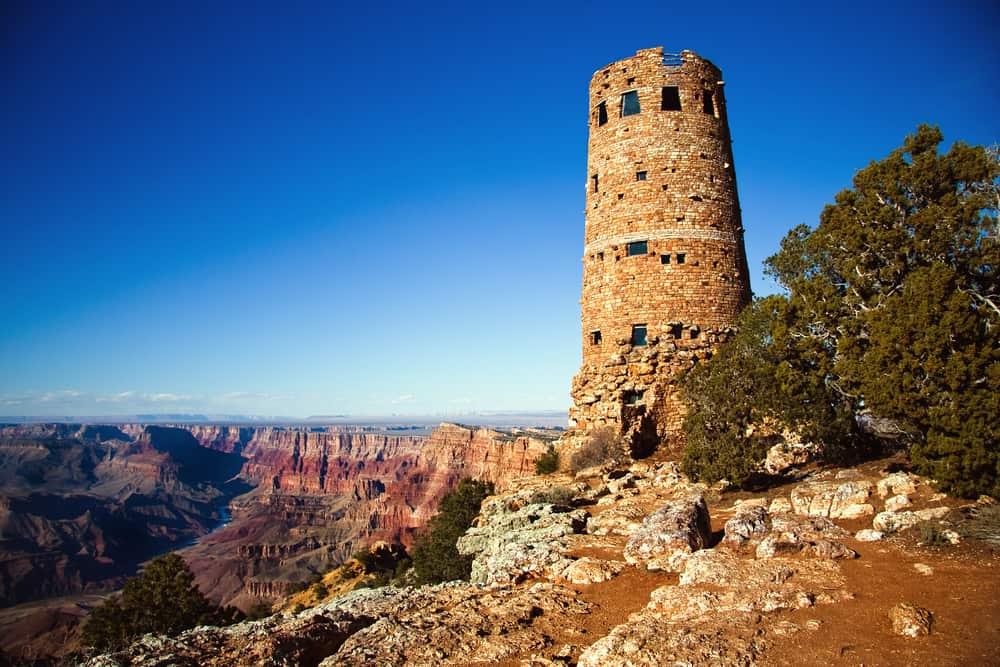
The view of the eastern side of the Grand Canyon from the Watchtower offers a distinctive viewpoint. Looking northeast from here, one can see in the distance where the Colorado River leaves the comparatively small Marble Canyon and enters the much larger Grand Canyon.
Tusayan Museum and Ruin
One of the most significant archaeological finds in Arizona is the 3-mile-west of Desert View Point, Tusayan Museum, and Ruin.
The ruins of a Pueblo village, thought to be over 800 years old, can be found inside the ruins themselves. The museum, which is adjacent to the ruins, houses a variety of displays that aim to help visitors better appreciate the special history of the canyon.
A beautiful winter day would be perfect for visiting the museum and learning about the 12,000+ years of fascinating archeological history.
Recent Posts
15 Tips for Visiting the Grand Canyon in September – 2023 Ultimate Guide
Visiting the Grand Canyon in September is a great time to visit. September is a busy time to visit but the crowds are starting to arrive especially toward the end of the month. I’ve included...
15 Tips for Visiting the Grand Canyon in August – 2023 Ultimate Guide
Visiting the Grand Canyon in August is a great time to visit. August is a busy time to visit but the crowds are starting to arrive especially toward the end of the month. I’ve included all...
